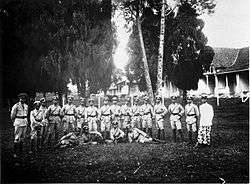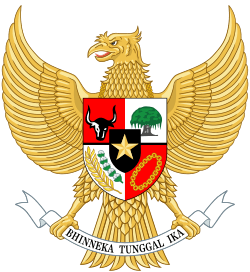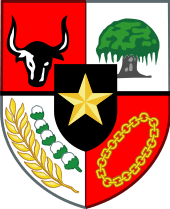Indonesian National Police
The Indonesian National Police (Indonesian: Kepolisian Negara Republik Indonesia, literally State Police of the Republic of Indonesia, abbreviated as POLRI) is the national police force of Indonesia. Founded on 1 July 1946, it was formerly a part of the country's military since 1962. The police were formally separated from the military on 1 April 1999 in a process which was formally completed on 1 July 2000.[2]
| Indonesian National Police Kepolisian Negara Republik Indonesia | |
|---|---|
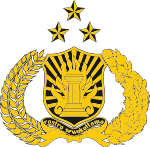 Logo of Indonesian National Police | |
| Abbreviation | POLRI |
| Motto | Sanskrit: Rastra Sewakottama (Serving the Nation) |
| Agency overview | |
| Formed | 1 July 1946 |
| Employees | 590,000+ |
| Jurisdictional structure | |
| National agency (Operations jurisdiction) | Indonesia |
| Operations jurisdiction | Indonesia |
| Legal jurisdiction | National |
| Constituting instrument |
|
| General nature | |
| Operational structure | |
| Headquarters | Kebayoran Baru, South Jakarta |
| Agency executives |
|
| Notables | |
| Anniversary |
|
| Website | |
| www | |
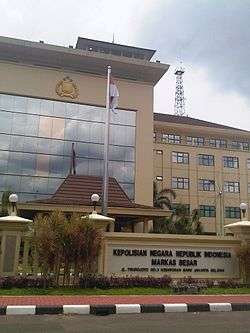
The organisation is now independent and is under the direct auspices of the President of Indonesia, while the Armed Forces is under the Ministry of Defence. The Indonesian National Police is responsible for law enforcement and policing duties all over Indonesia. The organisation is widely known for its corruption, violence and incompetence.[3]
The Indonesian National Police also takes part in international United Nations missions, and after special training, provided security for the UNAMID mission to protect internally-displaced people in Darfur.[4]
The strength of the Indonesian National Police stood at approximately 387,470 in 2011 and the number is increasing every year. It also includes up-to 12,000 water police (Polair) personnel and an estimated 40,000 People's Security (KAMRA) trainees who serve as a police auxiliary and report for three weeks of basic training each year.
The headquarters of the Indonesian National Police is located in Kebayoran Baru.
History
When Indonesia was under Dutch colonial rule until the 1940s, police duties were performed by either military establishments or colonial police known as the veldpolitie or the field police.[5] Japanese occupation during WW II brought changes when the Japanese formed various armed organisations to support their war. This had led to the distribution of weapons to military trained youths, which were largely confiscated from the Dutch armoury.
After the Japanese occupation, the national police became an armed organisation. The Indonesian police was established on 19 August 1945 (under the title of the National Police Agency (Badan Kepolisian Negara)) and its units fought in the Indonesian National Revolution against the invading Dutch forces. The police also participated in suppressing the 1948 communist revolt in Madiun. In 1962, the police was brought under the control of the Commander of the National Armed Forces and the Ministry of Defence, becoming the Indonesian Police Forces (Angkatan Kepolisian). Following the proclamation of independence, the police played a vital role when they actively supported the people's movement to dismantle the Japanese army, and to strengthen the defence of the newly created Republic of Indonesia. The police were not combatants who were required to surrender their weapons to the Allied Forces. During the revolution of independence, the police gradually formed into what is now known as Kepolisian Negara Republik Indonesia (Polri) or the Indonesian National Police. In April 1999, the police force officially regained its independence and now is separate from the armed forces proper.
1 July, which is marked as National Police Day (Hari Bhayangkara), honours the anniversary of the 1946 Cabinet resolution placing the INP as a national agency subordinated directly to the government of the Republic and thus responsible to the President (formerly the Prime Minister).
Duties and tasks
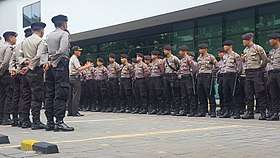
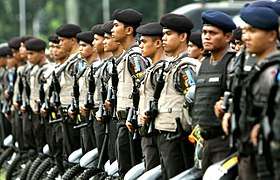
The key tasks of the Indonesian National Police are to:
- maintain security and public order;
- enforce the law, and
- provide protection, and service to the community.
In carrying out these basic tasks, Police are to:
- perform control, guard, escort and patrol of the community and government activities as needed;
- supplying all activities to ensure the safety and smoothness of traffic on the road;
- to develop community awareness;
- as well as in the development of national law;
- implement order and ensure public safety;
- implement co-ordination, supervision, and technical guidance to the investigators, civil servants/authorities, and the forms of private security;
- implement the investigation against all criminal acts in accordance with the criminal procedure law and other legislation;
- implement identification such as police medical operations, psychology, and police forensic laboratory for the interests of the police task;
- Protect soul safety, property, society, and the environment from disturbances and/or disaster, including providing aid and relief to uphold human rights;
- Serving interests of citizens for a while before it is handled by the agency and/or authorities;
- Give services to the public in accordance with the interests of the police task environment;
- to implement other duties in accordance with the legislation, which in practice regulated by Government Regulation;
- Receive reports and/or complaints;
- crowd and public control;
- help resolve community disputes that may interfere with the public order;
- supervising the flow that can lead to the dismemberment or threaten the unity of the nation;
- publicising police regulations within the scope of police administrative authority;
- implementing special examination as part of the police identification;
- respond first and rapid action to a scene;
- Take the identity, fingerprints and photograph of a person for identification purposes;
- looking for information and evidence;
- organising National Crime Information Centre;
- issuing licence and / or certificate that is required to service the community;
- Give security assistance in the trial and execution of court decisions, the activities of other agencies, as well as community activities; and
- to Receive, secure, and keep founded lost items for a while until further identification
Organisation
The organisation of the Indonesian National Police is hierarchical, culminating on the General Headquarters in Kebayoran Baru. Below the General Headquarters:
- Regional Police (Indonesian: Kepolisian Daerah, POLDA), formerly Police Commissariats (Kepolisian Komisariat), Regional Police Commands (Komando Daerah Kepolisan, KOMDAK) and Territorial Police (Polisi Wilayah): covers an entire province.
- Departamental Police (Indonesian: Kepolisian Resor, POLRES), formerly Police Area Directorates (Korem Polisi): covers second-level territories (regencies and cities)
- Sectoral Police (Indonesian: Kepolisian Sektor, POLSEK): covers regions below the cities and regencies.
Leadership element
The head of the National Police Headquarters is the Chief of the Indonesian National Police (Indonesian: Kepala Kepolisian Negara Republik Indonesia, KAPOLRI). The Chief of Police is appointed by and is responsible to the President of Indonesia. He is assisted by the Vice Chief of Police.
Auxiliary elements of leadership
- Office of the Inspectorate General of the National Police (Itwasum), tasked to assist the Chief of Police in the implementation of supervision and general inspection and treasury within the National Police including non-structural organizational units under the control of chief of national police.
- Assistant Chief of Police for Operations (As Ops), tasked to assist the Chief of Police in the implementation of operational management functions within the Police environment including external coordination and cooperation as well as community empowerment and other Polri auxiliary elements.
- Assistant Chief of Police for Planning and Development (Asrena), tasked to assist the Chief of Police in the implementation of general planning and development functions, including the development of organisational and management systems and research and development within the Indonesian national police.
- Assistant Chief of Police for Human Resources (AS HR), tasked to assist the Chief of Police in the implementation of human resources management functions including efforts to maintain and improve the welfare of personnel within the Indonesian national police.
- Assistant Chief of Police Facilities and Infrastructure (Assarpras), tasked to assist the Chief of Police in the implementation of the function of facilities and infrastructure within the Police.
- Division of Profession and Internal Security (Div Propam), is the special staffing element in the field of professional accountability and internal security. This division acts as the internal affairs of the police organisation in charge of enforcement of discipline and law and order of police personnel.
- Police Legal Division (Div Kum)
- Police Public Affairs and Press Directorate (Div Humas)
- Police International Relations and Transnational Crimes Division (Div Hubinter), is an assistant element of international relations leadership that is under the Chief of Police. This section oversees the National Crime Bureau Interpol (NCB Interpol), to deal with international crimes.
- Police Information Technology Division (IT Pol Div), is a supporting element in the field of informatics which includes information technology and electronic communications.
- Advisory Staff to the Chief of Police (Spripim)
- office of the Secretariat General (Kasetum).
- Headquarters Services (Kayanma).
- Expert staff of the Chief of Police (Staf Ahli Kapolri), tasked to provide a review of a particular problem to the national police chief according to their area of expertise
Central Executive Agencies
- Bureau of Intelligence and Security (Baintelkam) is responsible for fostering and performing intelligence functions in the field of security for the purpose of performing the operational and management duties of the Police as well as to support the implementation of government duties in order to realize domestic security.
- The Criminal Investigation Agency (Bareskrim) is responsible for fostering and conducting criminal investigation and investigation functions, including the function of forensic laboratory identification, in the context of law enforcement.
- The Security Maintenance Agency (Baharkam), is responsible for fostering and conducting security guidance functions that include the maintenance and efforts to improve the security and public order conditions in order to achieve domestic security.
- The Mobile Brigade Corps (Korbrimob) is in charge of performing security counseling functions particularly with regard to the handling of high-intensity security disturbances, in the framework of enforcement of internal security.
- Traffic Corps (Korlantas) is responsible for fostering and organizing traffic functions that include community education, law enforcement, traffic assessment, registration and identification of drivers and motor vehicles, and conducting road patrols.
- The Police Operations Bureau, tasked with dispatching units of Brimob, Sabhara, Traffic police, Jihandak / Explosive management troops, if necessary and an intelligence team if there are demonstrations, court hearings, high-level meetings, holiday celebrations by community groups, or inauguration rites as can be ordered by the head of government, the head of state, the chairman of the MPR, or the speakers of the DPR/DPD by sending a letter of assignment to the local Police Operations Bureau, the local Police Operations Bureau and the local Police.
- The Special Detachment 88 Anti-Terror unit (Densus 88 AT), is responsible for carrying out intelligence, prevention, investigation, enforcement and operational support functions in the investigation and investigation of terrorism crimes.
Supporting elements
- Police Educational Institutes and Training Command ( Lemdiklatpol) is in charge of planning, developing, and organising the function of education and training in formation and development of and to the scope of the Indonesian National Police for ensuring education of recruits or personnel which are specialising in particular policing units which includes the maintaining of professionalism, managerial, academic, and vocational education. The Police Education Institutes Command oversees:
- National Police Staff College (Sespimpol) is the education implementing element and special staff educational institution related to the development of Police management and administration. It consists of the National Police Advanced Officers' School (Sespinma) (formerly Selapa), National Police Junior Staff School (Sespimmen) (formerly Sespim) and the National Police Command and Staff Academy (Sespimti) (formerly Sespati).
- The Police Academy (Akpol), is the element of officer rank formation of Police recruits.
- Police Science and Technology College (STIK) is a special education and staffing element concerned with higher education and the development of police science and technology.
- Police Officers Candidate School (Setukpa) is the element of education for the formation of Police Officers to become officer rank originating from enlisted or constable ranks of policemen and policewomen.
- Police Bacherloriat Inspector School (SIPSS) is the element of education for the establishment of Police Officer Candidates for graduates of bachelor's degree.
- Police Educational Centres consists of:
- Special Education and Training of Crime and Violence (Diklatsus Jatanras)
- Intelligence Education and Training Centre (Pusdikintel)
- Criminal Investigation Education and Training Centre (Pusdikreskrim)
- Traffic Enforcement Education and Training Centre (Pusdiklantas)
- Public Security Education and Training Centre (Pusdikgasum)
- Mobile Brigade Education and Training School (Pusdikbrimob)
- Water Police Education and Training Centre (Pusdikpolair)
- Police Administration Education and Training Centre (Pusdikmin)
- Police Language College (Sebasa)
- Women's Police School (Sepolwan)
- Community Developing Education and Training Institute (Pusdikbinmas)
- Police Logistics, Equipment and Armaments Command
- Medical and Health Department (Pusdokkes Polri), including the National Police Hospital (Rumkit Puspol)
- Finance Office (Puskeu Polri)
- Police Research and Development Department (Puslitbang Polri)
- Historical and Cultural Affairs Department (Pusjarah Polri)
Regional Police
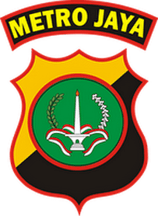
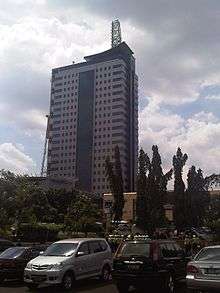
- The Regional Police of the Republic of Indonesia (Polda) is the main implementing unit of territoriality under the Chief of Police. Polda is responsible for carrying out national police duties at province level. A "Polda" is headed by a Regional Chief of Police (Kapolda), which is responsible to the Chief of national Police (Kapolri) and holds the rank of either Inspector General or Brigadier General. Kapolda is assisted by Deputy Chief of Police (Wakapolda).
- The Regional Police (Polda) is responsible for the Departmental Police of the Republic of Indonesia (Polres) which covers a city or district/municipal level in that province. For big cities, Departamental Police (Polres) forces are called Metropolitan Police (Polrestabes), and for the urban type it is named only City Police (Polresta). The Polres has a complete police task force, like a Polda, and is led by a Police Chief Commissioner (Kombes) (for city police) or Police Superintendent (AKBP) for regency police.
- Sectoral Police (Polsek) are led by a Police Superintendent (AKBP) or Police Commissioner (Kompol) (for urban divisions), while in other Poldas, Polseks are led by officers of Police chief inspector (AKP) rank for Rural areas. In some areas which are remote like Papua, a Polsek may be led by a Police Inspector 2nd Class (Ipda).
Each Regional Police headquarters (Polda) which covers a province oversees the following directorates:
- Criminal Investigation Directorate
- Sub-directorate of Criminal Affairs
- Sub-Directorate for Crimes of Violence (Jatanras)
- Sub-directorate for Teens, Children and Women affairs
- Inafis Unit (Indonesia Automatic Finger Print Identification System) / Identification of TKP (Crime Scene)
- Directorate of Special Crimes Investigation
- Sub-Directorate of Corruption
- Sub-directorate of Land and building Property (Hardabangtah)
- Sub-directorate of Cyber Crimes
- Directorate of Drug Investigation
- Narcotics Subdivision
- Psychotropic subdivision
- Directorate of Intelligence and Security
- Directorate of Traffic Security
- Sub Directorate of Education and Conjecture (Dikyasa)
- Sub Directorate of Registration and Identification (Regident)
- Sub Directorate of Traffic Law Enforcement (Gakkum)
- Sub Directorate of Road Security and Safety (Kamsel)
- Sub Directorate of Road Escort and Patrol (Patwal)
- Sub Directorate of Highway patrol (PJR)
- Animal Unit (Unit Satwa) - (mounted police and K9 dogs)
- Directorate of Community Guidance and Development (Bimmas, formerly Bina Mitra)
- Patrol Units (Sabhara) Directorate - ("Alert Unit")
- Directorate of VIP and Important Facility Protection (Pamobvit)
- Directorate of Water police (Polair)
- Directorate of Prisoners and Evidence Gathering (Tahti)
- Operations Bureau
- Human Resources Bureau
- Bureau of Infrastructure Facilities (Sarpras, formerly Logistic)
- Finance Office
- Bureau of internal Profession and Security (Propam) - (Internal affairs unit)
- Law Bureau
- Public Relations and Press Service
- Regional Police Medical Bureau
Units
Special units
| Units | Abbreviation | Explanation |
|---|---|---|
| Mobile Brigade Corps | Brimob | Brimob is the elite/special forces of the Indonesian National Police. Brimob is the paramilitary force of Indonesia and takes the duties for handling high-level threat of public secure also special police operations. This unit also becomes the back-up force for the riot control purposes. The personnel of this unit are identifiable with their dark blue berets. The Mobile Brigade is also known as the special ‘anti-riot’ branch of the Indonesian National Police which deals with special operations. A paramilitary organization, its training and equipment is almost identical to the Indonesian Army’s ("TNI"), and it conventionally operates under joint military command in areas such as Papua and, until 2005, Aceh.[6] |
| Gegana | - | Gegana is an internal unit of the Brimob special Police corps who have special abilities in the field of anti-terrorism, bomb disposal, intelligence, anti-anarchist, and handling of Chemical, Biological, and Radio Active threats. It also conducts hostage rescue operations |
| Detachment 88 | Densus 88 | (Detasemen Khusus 88), Delta 88, or Densus 88, is an Indonesian Special Forces counter-terrorism squad, and part of the Indonesian Police Force. Formed on 30 June 2003, after the 2002 Bali bombings, it is funded, equipped, and trained by the United States[7] and Australia.[8] |
Public units
The following fall under the Departamental police headquarters (Polres) of cities and regencies:
| Units | Abbreviation | Indonesian | Explanation |
|---|---|---|---|
| Centre of integrated police services | SPKT | Sentra Pelayanan Kepolisian Terpadu | The SPKT is responsible for providing police services to the public, in the form of first receipt and handling of reports / complaints, police assistance / assistance services, and related functions to carry out security and crime identification/prevention activities in accordance with applicable laws and regulations. |
| Intelligence and Security Unit | Sat-Intelkam | Satuan Intelijensi dan Keamanan | This unit is in charge of organizing / fostering the functions of Intelligence Security, including encryption, and service providers in the form of License / Explanation concerning Foreigners, Firearms & Explosives, social activities / Political Communities and Police Note Certificates (SKCK) to citizens in need And conduct supervision / security and its implementation. |
| Criminal Detective Unit | Sat-Reskrim | Satuan Reserse Kriminal | This unit is in charge of fostering Functions and conducting criminal investigation and investigation activities, including the function of identification in the framework of law enforcement, coordination and supervision of operations and administration of investigation in accordance with applicable laws and regulations. |
| Drug Detective Unit | Sat-Resnarkoba | Satuan Reserse Narkoba | This unit is responsible for conducting investigations and investigations of criminal acts of drug abuse, including counseling and guidance in the prevention and rehabilitation of drug abuse victims. |
| Community and Society Development Unit | Sat-Binmas | Satuan Bina Masyarakat | This unit is in charge to carry out community guidance, including community empowerment activities, public order and coordination activities with other forms of security, as well as cooperative activities in maintaining security and public order. |
| Patrol Unit | Sat-Sabhara | Satuan Samapta Bhayangkara | The Sabhara unit has the tasks for supervision of the public order and public security. It conducts patroling and basic law enforcement. This unit usually becomes the first dispatch for first crime scenes, policing activities and public matters affairs. They also perform Riot Police duties. |
| Traffic Unit | Sat-Lantas | Satuan Lalu Lintas | This unit is in charge for Traffic law enforcement, control, management, and patrolling affairs |
| Vital Object Protection Unit | Sat-Pamobvit | Satuan Pengamanan Obyek Vital | This unit serves the security activities of VIP and important facilities, such as government official, diplomatic missions, industrial complex and tourism Area.[9] |
| Water unit | Sat-Polair | Satuan Polisi Perairan | This unit is responsible for carrying out the functions of aquatic police, which include water patrols, waters law enforcement, coastal community development and other waters, as well as search and rescue accidents in marine areas (SAR) |
| Detainees and evidence unit | Sat-Tahti | Satuan Tahanan dan Barang Bukti | This internal unit is in charge to organize prisoners' care includes the health care of the detainee, the guardianship of the prisoners and the receiving, storing and securing of evidence and their administration within the regional police headquarters, reporting the number and condition of the detainees in accordance with the provisions of the law. |
| Information technology unit | Si-Tipol | Seksi Teknologi Informasi Polri | This unit is responsible for Computer and IT system management and development for policing duties |
Corruption
In the eyes of the people, the National Police force is "corrupt, brutal, and inept".[3] Even becoming a police officer can be expensive, with applicants having to pay up to Rp90 million, according to Indonesia Police Watch head, Neta Saputra Pane.[10]
In April 2009, angry that the Corruption Eradication Commission (KPK) had tapped his phone while investigating a corruption case, Indonesian Police chief detective Susno Duadji compared the KPK to a gecko (Indonesian: cicak) fighting a crocodile (Indonesian: buaya) meaning the police. Susno's comment, as it turned out, quickly backfired because the image of a cicak standing up to a buaya (similar to David and Goliath imagery) immediately had wide appeal in Indonesia. A noisy popular movement in support of the cicak quickly emerged. Students staged pro-cicak demonstrations, many newspapers ran cartoons with cicaks lining up against an ugly buaya, and numerous TV talk shows took up the cicak versus buaya topic with enthusiasm. As a result, references to cicaks fighting a buaya have become a well-known part of the political imagery of Indonesia.[11]
In June 2010, the Indonesian news magazine Tempo published a report on "fat bank accounts" held by senior police officers containing billions of rupiah. When the magazine went on sale in the evening groups of men said by witnesses to be police officers, went to newsstands with piles of cash to try to buy all the copies before they could be sold.[12][13]
When KPK investigators tried to search Polri headquarters in 2010 as part of an investigation into Djoko Susilo, then the head of Korlantas (police corps of traffic), they were detained, and only released following the intervention of the president, Susilo Bambang Yudhoyono. Following a trial, Djoko was jailed for 18 years. Two years later, the KPK began investigating another senior police officer, Budi Gunawan, who was subsequently nominated for the post of National Police Chief. The KPK then named Budi a suspect and his nomination was withdrawn. However, he was later sworn in as deputy police chief. The police subsequently took revenge by charging three KPK commissioners with criminal offenses.[14][15]
Violence and human rights abuses
Amnesty International has accused Polri of "widespread" torture and other abuses of arrested individuals.[16] According to the organization, "Police in Indonesia shoot, beat and even kill people without fear of prosecution, leaving their victims with little hope of justice".[17]
In 2014 the Human Rights Watch reported that a physical virginity test is routinely performed on female applicants to the police force.[18] Human Rights Watch decried the practice as unscientific and degrading.[18]
An official admission of violence by police officers came in 2016 when Chief Gen. Badrodin Haiti admitted that officers of the Detachment 88 anti-terror unit were responsible for the death in custody of terrorist suspect Siyono, who died of heart failure after being kicked hard enough in the chest to fracture his ribs. The Indonesian National Commission on Human Rights stated in March 2016 that at least 121 terror suspects had died in custody since 2007[19]
Amnesty International called in June 2019 for an investigation of "credible evidence" of a range of grave violations by police, who it alleged were responsible for 10 unlawful killings in the aftermath of the re-election of president Joko Widodo.[20]
In July 2020, the Indonesian Commission for Missing Persons and Victims of Violence (KontraS) issued a report detailing police brutality over the preceding year that resulted in 304 deaths and 1,627 injuries in 921 violent incidents. The report also mentioned arbitrary arrests of people demonstrating legally, and acts of discrimination towards ethnic Papuans.[21]
Rank structure
In the early years, the Indonesian Police used European police style ranks like "inspector" and "commissioner". When the police were amalgamated with the military structure during the 1960s, the ranks changed to a military style such as "Captain", "Major" and "Colonel". In the year 2000, when the Indonesian Police conducted the transition to a fully independent force out of the armed forces, they used British style police ranks like "Inspector" and "Superintendent". In 2001, the Indonesian Police have returned to Dutch style ranks like "Brigadier" and "Inspecteur" just like in the early years with some Indonesianized elements within the ranking system. The ranks are comparable with the armed forces' rank system.[22]
| Worn on: | General officers | Field officers | Subaltern officers | |||||||
|---|---|---|---|---|---|---|---|---|---|---|
| Ceremonial Dress Uniform (PDU) |  |
 |
 |
 |
 |
 |
 |
 |
 |
 |
| Service Uniform (PDH) |  |
 |
 |
 |
 |
 |
 |
 |
 |
 |
| Field Uniform (PDL) on collar |
 |
 |
 |
 |
 |
 |
 |
 |
 |
 |
| Rank in Indonesian: |
Jenderal Polisi | Komisaris Jenderal Polisi (Komjen) |
Inspektur Jenderal Polisi (Irjen) |
Brigadir Jenderal Polisi (Brigjen) |
Komisaris Besar Polisi (Kombes) |
Ajun Komisaris Besar Polisi (AKBP) |
Komisaris Polisi (Kompol) |
Ajun Komisaris Polisi (AKP) |
Inspektur Polisi Satu (Iptu) |
Inspektur Polisi Dua (Ipda) |
| Rank in English: |
Police General | Police Commissioner General | Police Inspector General | Police Brigadier General | Police Chief Commissioner | Police Commissioner | Police Deputy Commissioner | Police Chief Inspector | Police Inspector 1st Class |
Police Inspector 2nd Class |
| Worn on: | Sub-inspectors of Police (WO) |
Constables (NCO) | ||||
|---|---|---|---|---|---|---|
| Ceremonial Dress Uniform (PDU) |  |
 |
 |
 |
 |
 |
| Service Uniform (PDH) |  |
 |
 |
 |
 |
 |
| Field Uniform (PDL) on collar |
 |
 |
 |
 |
 |
 |
| Rank in Indonesian: |
Ajun Inspektur Polisi Satu (Aiptu) | Ajun Inspektur Polisi Dua (Aipda) | Brigadir Polisi Kepala (Bripka) | Brigadir Polisi (Brigpol) | Brigadir Polisi Satu (Briptu) | Brigadir Polisi Dua (Bripda) |
| Rank in English: |
Police Sub-Inspector 1st Class |
Police Sub-Inspector 2nd Class |
Police Chief Brigadier |
Police Brigadier | Police Brigadier 1st Class |
Police Brigadier 2nd Class |
The following ranks are only used by personnel serving in the Mobile Brigade Corps and Water police units:
| Worn on: | Enlisted | |||||
|---|---|---|---|---|---|---|
| Ceremonial Dress Uniform (PDU) |  |
 |
 |
 |
 |
 |
| Service Uniform (PDH) |  |
 |
 |
 |
 |
 |
| Field Uniform (PDL) on collar |
 |
 |
 |
 |
 |
 |
| Rank in Indonesian: | Ajun Brigadir Polisi (Abrigpol) | Ajun Brigadir Polisi Satu (Abriptu) | Ajun Brigadir Polisi Dua (Abripda) | Bhayangkara Kepala (Bharaka) | Bhayangkara Satu (Bharatu) | Bhayangkara Dua (Bharada) |
| Rank in English: | Police Adjutant Brigadier | Police Adjutant Brigadier 1st class |
Police Adjutant Brigadier 2nd class |
Senior Patrolman | Patrolman 1st class |
Patrolman |
Below is the rank system used prior, with its current equivalent. The system used before the transitional period followed the rank system in the Indonesian Army.
| Current | Transitional period (1 June – 31 December 2000) | Previous (until 31 May 2000) |
| Officers | ||
| General officers | ||
| Jenderal Polisi (Jenderal Pol) | Jenderal Polisi | Jenderal Polisi |
| Komisaris Jenderal Polisi (Komjen Pol) | Komisaris Jenderal Polisi | Letnan Jenderal Polisi (Letjen Pol, Police Lieutenant General) |
| Inspektur Jenderal Polisi (Irjen Pol) | Inspektur Jenderal Polisi | Mayor Jenderal Polisi (Mayjen Pol, Police Major General) |
| Brigadir Jenderal Polisi (Brigjen Pol) | Brigadir Jenderal Polisi | Brigadir Jenderal Polisi |
| Field officers | ||
| Komisaris Besar Polisi (Kombes Pol) | Senior Superintendent | Kolonel Polisi (Police Colonel) |
| Ajun Komisaris Besar Polisi (AKBP) | Superintendent | Letnan Kolonel Polisi (Letkol Pol, Police Lieutenant Colonel) |
| Komisaris Polisi (Kompol) | Asisten Superintendent (Superintendent Assistant) | Mayor Polisi (Police Major) |
| Subaltern officers | ||
| Ajun Komisaris Polisi (AKP) | Senior Inspektur Polisi | Kapten Polisi (Police Captain) |
| Inspektur Polisi Satu (Iptu) | Inspektur Polisi I | Letnan Satu Polisi (Lettu Pol, Police First Lieutenant) |
| Inspektur Polisi Dua (Ipda) | Inspektur Polisi II | Letnan Dua Polisi (Letda Pol, Police Second Lieutenant) |
| Sub-inspectors of Police (WO) | ||
| Ajun Inspektur Polisi Satu (Aiptu) | Ajun Inspektur Polisi I | Pembantu Letnan Satu Polisi (Peltu Pol, Police Chief Warrant Officer) |
| Ajun Inspektur Polisi Dua (Aipda) | Ajun Inspektur Polisi II | Pembantu Letnan Dua Polisi (Pelda Pol, Police Warrant Officer) |
| Constables (NCO) | ||
| Brigadir Polisi Kepala (Bripka) | Sersan Mayor Polisi | Sersan Mayor Polisi (Serma Pol, Police Sergeant Major) |
| Brigadir Polisi (Brigpol) | Sersan Kepala Polisi | Sersan Kepala Polisi (Serka Pol, Police Master Sergeant) |
| Brigadir Polisi Satu (Briptu) | Sersan Satu Polisi | Sersan Satu Polisi (Sertu Pol, Police Staff Sergeant) |
| Brigadir Polisi Dua (Bripda) | Sersan Dua Polisi | Sersan Dua Polisi (Serda Pol, Police Sergeant) |
| Enlisted | ||
| Ajun Brigadir Polisi (Abrip) | Bhayangkara Utama I | Kopral Kepala (Police Master corporal) |
| Ajun Brigadir Polisi Satu (Abriptu) | Bhayangkara Utama II | Kopral Satu (Police Corporal) |
| Ajun Brigadir Polisi Dua (Abripda) | Bhayangkara Utama Muda | Kopral Dua (Police Lance Corporal) |
| Bhayangkara Kepala (Bharaka) | Bhayangkara Kepala | Prajurit Kepala (Police Master Constable) |
| Bhayangkara Satu (Bharatu) | Bhayangkara I | Prajurit Satu (Police Constable First Class) |
| Bhayangkara Dua (Bharada) | Bhayangkara II | Prajurit Dua (Police Constable) |
Firearms
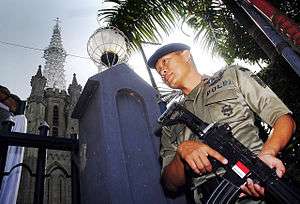
The standard issue sidearm to all Indonesian National Police officers is the Taurus Model 82 revolver in. 38 Special. While police personnel attached to special units such as Detachment 88, Gegana and BRIMOB are issued with the Glock 17 semi-automatic pistol.
Heavy arms are always available to Indonesian police personnel, such as the Heckler & Koch MP5 sub-machine gun, Remington 870 shotgun, Steyr AUG assault rifle, M4 carbine, M1 Carbine. and other weapons. The standard rifle for the Indonesian National Police are the Pindad SS1 and the M16 rifle. Units are also issued the "Sabhara"/Police V1-V2 Pindad SS1 special law enforcement assault rifle.
Police Vehicles
The police vehicles that are usually operated by the Indonesian Police ("Polri") for patrol and law enforcement activities are mainly Ford Focus sedans, Mitsubishi Lancers, Hyundai Elantras (for some police regions), Mitsubishi Stradas, Isuzu D-Maxs, and Ford Rangers. Such vehicles are usually operated by the "Sabhara" police unit and other units which the vehicles are mainly colored dark-grey. In some areas, usually in rural places, the vehicles are not up-to date compared to the ones in the major urban areas in the country, so some police vehicles still use older versions such as the Toyota Kijang and Mitsubishi Freecas.
Special Investigation units usually operate in black Toyota Avanzas and some are unmarked vehicles. Police laboratory and forensics ("Puslabfor") units are issued dark-grey police Suzuki APV vehicles.
The Traffic Police Corps ("Korlantas") usually uses vehicles such as the Mazda 6, Mitsubishi Lancer Evolution, Toyota Vios, Ford Focus sedans, Hyundai Elantra and Ford Rangers coloured white and blue. Some vehicles for traffic patrol are also used such as the Toyota Rush and Daihatsu Terios. Sedan types are usually used for highway and road patrolling and escort. Double-Cab types are usually used for Traffic incidents and traffic management law enforcement activities.
Police vehicles coloured orange usually Ford Focus and Mitsubishi Lancer sedans and white-orange Chevrolet Captivas are operated by the Vital Object Protection unit ("Pam Obvit") and usually parked outside and operated for international embassies, airports, and other special specified locations. It is also used by the Tourist police for patrol.
For the special police, counter-terrorism and anti-riot units such as the Mobile Brigade or "Brimob", Detachment 88 and "Gegana" units usually use special costumed vehicles for special operations such as the Pindad Komodo, Barracuda APC, and modified armored Mitsubishi Stradas, 2002 Nissan Terrano Spirits' and other special double-cabin and SUV vehicle types. Vehicles are coloured dark-grey with the bumper coloured orange identifying vehicles of the special police units. Some special operational "Gegana" and "Densus 88" vehicles are coloured black also with orange bumpers.
Other customised vehicles used for mobilisation of police personnel are usually modified Suzuki Mega Carrys, Isuzu Elfs and Toyota Dynas with horizontal side sitting facilities inside of the trunk covered by dark colored canvas for canopy. Costumed patrol pick-ups with mounted sitting facilities on the trunk covered with canopy are also operated by the police to carry police personnel during patrol, the pick-ups are usually Isuzu Panther pick-ups and usually operate in rural areas.
For high-ranking officers (usually generals), issued cars are usually grey (some black) full to compact sedans and Mid to Full-sized SUVs. Such cars are mainly chauffeured Toyota Camrys, Hyundai Sonatas, Toyota Land Cruisers, and Toyota Prados. Some use black Toyota Innovas.
 A Mitsubishi Lancer patrol car used by Sabhara patrol unit officers
A Mitsubishi Lancer patrol car used by Sabhara patrol unit officers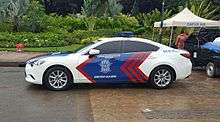 A Mazda6 patrol car used by the Traffic unit
A Mazda6 patrol car used by the Traffic unit A Customized Ford Ranger used by the Mobile Brigade Corps
A Customized Ford Ranger used by the Mobile Brigade Corps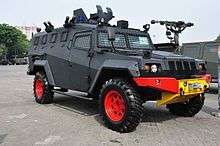 A Pindad Komodo Indonesian Mobile Brigade special police tactical vehicle
A Pindad Komodo Indonesian Mobile Brigade special police tactical vehicle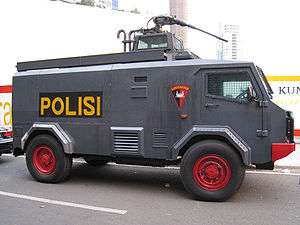 Police Mobile Brigade riot vehicle
Police Mobile Brigade riot vehicle- Yamaha Indonesian Traffic police motorcycle
.jpg) Barracuda APC Mobile Brigade riot control vehicle
Barracuda APC Mobile Brigade riot control vehicle.jpg) Daihatsu Gran Max Indonesian Tourist Police Service Van
Daihatsu Gran Max Indonesian Tourist Police Service Van An Indonesian Police patrol vehicle circa 1976
An Indonesian Police patrol vehicle circa 1976 An Indonesian K9 Police Unit Vehicle
An Indonesian K9 Police Unit Vehicle Police Off-Road Motorcycle (Dirt Bike) units
Police Off-Road Motorcycle (Dirt Bike) units
Uniform
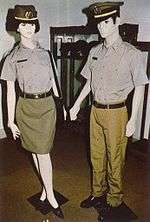
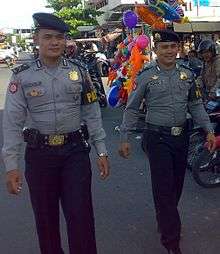
The National Police Force of Indonesia had changes for uniform colours about 3 times, the periods are:
- Since first formed until mid 70s, the uniform colour was khaki like the current Indian Police uniform.
- Since the late 70s until mid 90s, the uniform colour was light brown and brown.
- Since mid 90s until now the colour are brownish grey and dark brown.
In the Indonesian Armed Forces and Police, there are three types of uniform worn by service personnel which are Ceremonial uniform (PDU), service uniform (PDH), and field uniform (PDL).
Headgears and beret colors:
- Red - Crime Investigation Unit ("Reserse") - don't wear berets during activity
- Dark Blue beret - Mobile Brigade Corps (Brimob)
- Blackish Dark Brown beret - "Sabhara"
- Light Blue beret - Internal Affairs Division (Police Provosts)
- Peaked cap with White top - Traffic Policemen
Personnel
 Sabhara
Sabhara Sabhara Patrolmen
Sabhara Patrolmen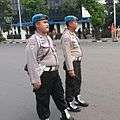 Internal Affairs (Provosts)
Internal Affairs (Provosts)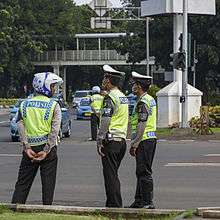 Traffic Policemen
Traffic Policemen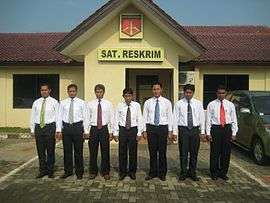 Criminal Detective Unit personnel
Criminal Detective Unit personnel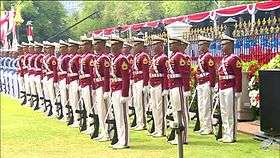 Police Academy Cadets
Police Academy Cadets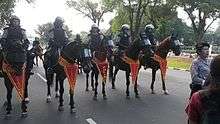 Mounted Police
Mounted Police K9 Policemen circa 1970s
K9 Policemen circa 1970s Police Aviators
Police Aviators Water Police
Water Police Aviation officers
Aviation officers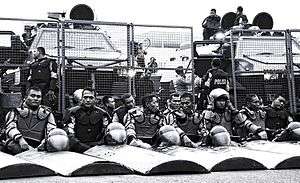 Riot police
Riot police Motorcycle Cop
Motorcycle Cop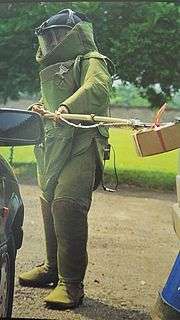 Bomb unit
Bomb unit
List of Chiefs of Police (Kapolri)
Police operational regions


































Police vehicles
 A Mitsubishi Lancer patrol car used by Sabhara patrol unit officers
A Mitsubishi Lancer patrol car used by Sabhara patrol unit officers A Mazda6 patrol car used by the Traffic unit
A Mazda6 patrol car used by the Traffic unit A Customized Ford Ranger used by the Mobile Brigade Corps
A Customized Ford Ranger used by the Mobile Brigade Corps A Pindad Komodo Indonesian Mobile Brigade special police tactical vehicle
A Pindad Komodo Indonesian Mobile Brigade special police tactical vehicle Police Mobile Brigade riot vehicle
Police Mobile Brigade riot vehicle- Yamaha Indonesian Traffic police motorcycle
.jpg) Barracuda APC Mobile Brigade riot control vehicle
Barracuda APC Mobile Brigade riot control vehicle.jpg) Daihatsu Gran Max Indonesian Tourist Police Service Van
Daihatsu Gran Max Indonesian Tourist Police Service Van An Indonesian Police patrol vehicle circa 1976
An Indonesian Police patrol vehicle circa 1976 An Indonesian K9 Police Unit Vehicle
An Indonesian K9 Police Unit Vehicle Police Off-Road Motorcycle (Dirt Bike) units
Police Off-Road Motorcycle (Dirt Bike) units
Popular media works related to POLRI
- Menumpas Teroris, 1986 - starring Barry Prima and El Manik
- Arie Hanggara, 1985: A true story of the death of an 8 year old boy by his stepmother starring Deddy Mizwar
- The Raid (2011 film), starring Iko Uwais, Joe Taslim & Donny Alamsyah
- Java Heat, 2013 starring Kellan Lutz, Ario Bayu, T.Wifnu Wikana & Mickey Rourke
Television programmes
- 86 - 2014–present (based on show Cops), shown on NET TV every day at 11 pm Western Indonesian Time
- The Police, every day at 11 pm Western Indonesian Time on Trans 7
See also
References
- "Undang-Undang Republik Indonesia Nomor 2 Tahun 2002".
- "Indonesian police split from military", Reuters, CNN, 1 April 2009, retrieved 18 September 2009
- Davies, Sharyn Graham; Meliala, Adrianus; Buttle, John, Indonesia’s secret police weapon (Jan-Mar 2013 ed.), Inside Indonesia, retrieved 8 December 2015
- "Sudan Focus: United Nations Mission in Sudan (UNMIS) introduces Community Policing in Internally Displaced Persons (IDP) camps in Khartoum" (PDF), UN Police Magazine (5 ed.), United Nations, p. 16, July 2010, retrieved 30 April 2019
- "Website Resmi Polri". www.polri.go.id. Retrieved 4 December 2019.
- "Background on Kopassus and Brimob", etan., etan.org, 2008, retrieved 6 March 2016
- Detachment 88, Kopassus Get Covert US Aid: US Intelligence Personnel Tap Indonesian Phones. Retrieved on July 16, 2008.
- "The eastern fringe of the Muslim world worries about Islamic State's influence". The Economist. 23 January 2016. Retrieved 24 January 2016.
- "Pam Obvit Metro Jaya – Website Resmi Direktorat Pengamanan Objek Vital Polda Metro Jaya" (in Indonesian). Retrieved 4 December 2019.
- Allard, Tom (10 May 2010), Indonesia pays a high price for its corrupt heart, Sydney Morning Herald, retrieved 8 December 2015
- Antagonism between the KPK and the police, with memories of the cicak versus buaya clash, remained deeply embedded in the relationship between the KPK and the police after the clash. See, for example, references to the clash in 2012 in Ina Parlina, 'Doubts over KPK inquiry into police bank accounts', The Jakarta Post, 18 May 2012.
- Fat Bank Accounts of POLRI Chief Candidates, Tempo, 26 July 2013, retrieved 8 December 2015
- Deutsch, Anthony (29 June 2010), The disappearing magazine and Indonesian media freedom, Financial Times, retrieved 8 December 2015
- Butt, Simon; Lindsey, Tim (11 April 2015), Joko Widodo's support wanes as Indonesia's anti-corruption agency KPK rendered toothless, The Age, retrieved 8 December 2015
- Budi Gunawan sworn in as deputy police chief, The Jakarta Post, 22 April 2015, retrieved 8 December 2015
- Cop Killers, The Economist, 4 November 2010, retrieved 8 December 2015
- Indonesia must end impunity for police violence, Amnesty International, 25 April 2012, retrieved 8 December 2015
- Human Rights Watch (18 November 2014). "Indonesia: 'Virginity Tests' for Female Police". Retrieved 19 November 2014.
- Eko Prasetyo (22 April 2016), Police Negligence Admission only Tip of the Iceberg: Amnesty International, The Jakarta Globe, archived from the original on 23 April 2016, retrieved 22 April 2016
- AP (26 June 2019), Amnesty wants impartial probe of Indonesia police violence, federalnewsnetwork.com, retrieved 13 September 2019
- Alya Nurbaiti; Tri Indah Oktavianti (1 July 2020), Rights groups highlight cases of police brutality on National Police’s 74th anniversary, The Jakarta Post, retrieved 5 July 2020
- Indonesia Company Laws and Regulations Handbook : Volume 1 Strategic Information and Basic Laws. International Business Publications USA. p. 99. ISBN 1-5145-0900-8.

Further reading
- Amnesty International. (2009) "Indonesia: Unfinished Business: Police Accountability in Indonesia" (24 June 2009)
- International Crisis Group. (2001) Indonesia : National Police reform. Jakarta / Brussels : International Crisis Group. ICG Asia report; no.13
- David Jansen. (2008) "Relations among security and law enforcement institutions in Indonesia", Contemporary Southeast Asia, Vol.30, No.3, 429-54
- "Networked Security in Indonesia: The Case of the Police in Yogyakarta." Doctoral Dissertation, Australian National University (April 2010).
External links
| Wikimedia Commons has media related to Indonesian National Police. |
